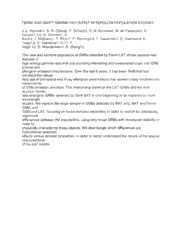
NASA Technical Reports Server (NTRS) 20110009940: Fermi and Swift Gamma-Ray Burst Afterglow Population Studies PDF
Preview NASA Technical Reports Server (NTRS) 20110009940: Fermi and Swift Gamma-Ray Burst Afterglow Population Studies
FERMI AND SWIFT GAMMA-RAY BURST AFTERGLOW POPULATION STUDIES J. L. Racusin1, S. R. Oates2, P. Schady3, D. N. Burrows4, M. de Pasquale2, D. Donat01 ,5,6, N. Gehrels1, S Koch4, J. McEnery1, T. Piran7, P. Roming4,8, T. Sakamot01, C. Swenson4, E. Troja1,9, V. Vasileiou1,10,11, F. Virgili 12, D. Wanderman7, B. Zhang12 The new and extreme population of GRBs detected by Fermi-LAT shows several new features in high energy gamma-rays that are providing interesting and unexpected clues into GRB prompt and afterglow emission mechanisms. Over the last 6 years, it has been Swift that has provided the robust data set of UV/ optical and X-ray afterglow observations that opened many windows into components of GRB emission structure. The relationship between the LAT GRBs and the well studied, fainter, less energetic GRBs detected by Swift-BAT is only beginning to be explored by multi wavelength studies. We explore the large sample of GRBs detected by BAT only, BAT and Fermi GBM, and GBM and LAT, focusing on these samples separately in order to search for statistically significant differences between the populations, using only those GRBs with measured redshifts in order to physically characterize these objects. We disentangle which differences are instrumental selection effects versus intrinsic properties, in order to better understand the nature of the special characteristics of the LAT bursts.
